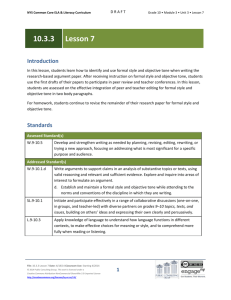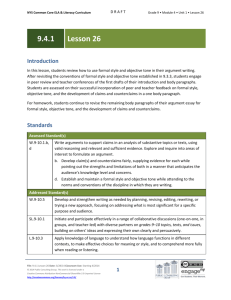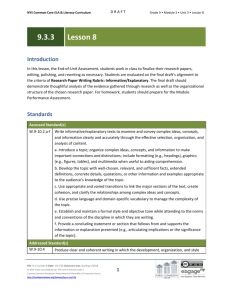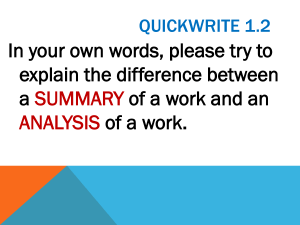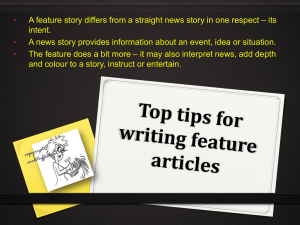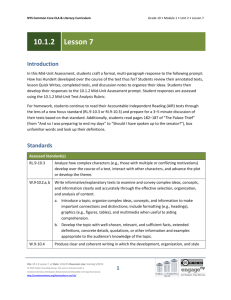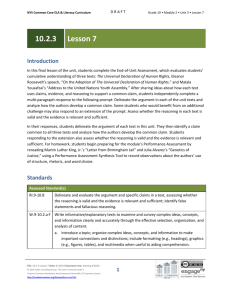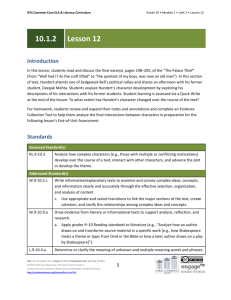1.87 MB - EngageNY
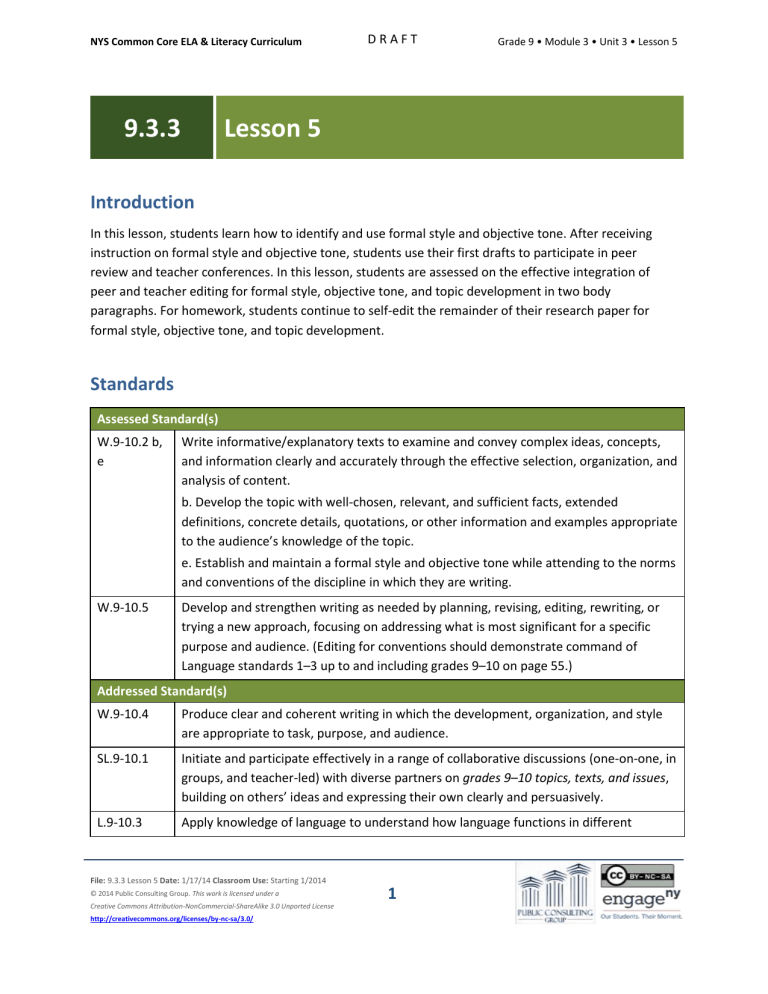
NYS Common Core ELA & Literacy Curriculum
9.3.3 Lesson 5
D R A F T
Grade 9 • Module 3 • Unit 3 • Lesson 5
Introduction
In this lesson, students learn how to identify and use formal style and objective tone. After receiving instruction on formal style and objective tone, students use their first drafts to participate in peer review and teacher conferences. In this lesson, students are assessed on the effective integration of peer and teacher editing for formal style, objective tone, and topic development in two body paragraphs. For homework, students continue to self-edit the remainder of their research paper for formal style, objective tone, and topic development.
Standards
Assessed Standard(s)
W.9-10.2 b, e
Write informative/explanatory texts to examine and convey complex ideas, concepts, and information clearly and accurately through the effective selection, organization, and analysis of content. b. Develop the topic with well-chosen, relevant, and sufficient facts, extended definitions, concrete details, quotations, or other information and examples appropriate to the audience’s knowledge of the topic. e. Establish and maintain a formal style and objective tone while attending to the norms and conventions of the discipline in which they are writing.
W.9-10.5
Addressed Standard(s)
W.9-10.4 Produce clear and coherent writing in which the development, organization, and style are appropriate to task, purpose, and audience.
SL.9-10.1
Develop and strengthen writing as needed by planning, revising, editing, rewriting, or trying a new approach, focusing on addressing what is most significant for a specific purpose and audience. (Editing for conventions should demonstrate command of
Language standards 1–3 up to and including grades 9–10 on page 55.)
L.9-10.3
Initiate and participate effectively in a range of collaborative discussions (one-on-one, in groups, and teacher-led) with diverse partners on grades 9–10 topics, texts, and issues, building on others’ ideas and expressing their own clearly and persuasively.
Apply knowledge of language to understand how language functions in different
File: 9.3.3 Lesson 5 Date: 1/17/14 Classroom Use: Starting 1/2014
© 2014 Public Consulting Group. This work is licensed under a
Creative Commons Attribution-NonCommercial-ShareAlike 3.0 Unported License http://creativecommons.org/licenses/by-nc-sa/3.0/
1
NYS Common Core ELA & Literacy Curriculum
D R A F T
Grade 9 • Module 3 • Unit 3 • Lesson 5 contexts, to make effective choices for meaning or style, and to comprehend more fully when reading or listening.
Assessment
Assessment(s)
The learning in this lesson will be captured through incorporation of peer and teacher feedback, regarding formal style and objective tone in two body paragraphs.
This assessment will be evaluated using the W.9-10.2.b, e portion of the Informative/Explanatory
Research Paper Writing Rubric and Checklist (located in the 9.3.3 Rubric and Checklist Packet).
High Performance Response(s)
A high performance response may include the following:
Pre-Revision:
For some reason, the ancient Greeks thought that there was a ladder of intelligence or something . And humans were super close to angels but animals weren’t as close (Waal). For a while most scientists and philosophers thought things like that, saying stuff like animals had no souls, and that they could “learn” but not “think” or “feel.” I think that a lot of people who made these claims didn’t try so hard to discover signs of animal thinking. They would always test the animals in ways that were appropriate for human subjects and everything , but not for the animals themselves.
Post-Revision:
The ancient Greeks thought that there was a ladder of intelligence, with all life forms ranking from low to high, and humans were the closest things to angels on earth (Waal). From then until somewhat recently , many scientists and philosophers followed this idea in one way or another, claiming that animals had no souls, and that they could potentially “learn” but not “think” or “feel” (Waal).
Most people who made these claims did not try very hard to discover signs of animal cognition, and would often test the animals in ways that were appropriate for human subjects, but not for the animals themselves.
Vocabulary
Vocabulary to provide directly (will not include extended instruction)
objective tone (n.) – a style of writing not influenced by personal feelings or opinions that is based on fact and makes use of the third-person point-of-view
subjective tone (n.) – a style of writing that involves personal opinion and expression
File: 9.3.3 Lesson 5 Date: 1/17/14 Classroom Use: Starting 1/2014
© 2014 Public Consulting Group. This work is licensed under a
Creative Commons Attribution-NonCommercial-ShareAlike 3.0 Unported License http://creativecommons.org/licenses/by-nc-sa/3.0/
2
NYS Common Core ELA & Literacy Curriculum
D R A F T
Grade 9 • Module 3 • Unit 3 • Lesson 5
norms (n.) – standards, models, or patterns
discipline (n.) – branch of learning or instruction
colloquial (adj.) – used in conversation
Vocabulary to teach (may include direct word work and/or questions)
None.*
*Students should be using their Vocabulary Journal to incorporate domain-specific vocabulary from Unit
9.3.2 into their research paper, as well as to record process-oriented vocabulary defined in the lesson.
Lesson Agenda/Overview
Student-Facing Agenda
Standards & Text:
Standards: W.9-10.2.b, e, W.9-10.5, W.9-10.4, SL.9-10.1, L.9-10.3
Text: Sources from research
Learning Sequence:
1.
Introduction of Lesson Agenda
2.
Homework Accountability
3.
Objective and Formal Tone
4.
Peer Review and Teacher Conference
5.
Lesson Assessment
6.
Closing
% of Lesson
1.
10%
2.
10%
3.
15%
4.
40%
5.
20%
6.
5%
Materials
Student copies of the 9.3 Core Curriculum Learning Standards Tool (refer to 9.3.1 Lesson 1)
Student copies of the 9.3.3 Rubric and Checklist Packet
Student copies of the Connecting Ideas Handout (refer to 9.3.3 Lesson 4)
Learning Sequence
How to Use the Learning Sequence
Symbol Type of Text & Interpretation of the Symbol
10% Percentage indicates the percentage of lesson time each activity should take.
File: 9.3.3 Lesson 5 Date: 1/17/14 Classroom Use: Starting 1/2014
© 2014 Public Consulting Group. This work is licensed under a
Creative Commons Attribution-NonCommercial-ShareAlike 3.0 Unported License http://creativecommons.org/licenses/by-nc-sa/3.0/
3
NYS Common Core ELA & Literacy Curriculum
D R A F T no symbol
Plain text indicates teacher action.
Bold text indicates text dependent questions.
Italicized text indicates a vocabulary word.
Indicates student action(s).
Indicates possible student response(s) to teacher questions.
Indicates instructional notes for the teacher.
Grade 9 • Module 3 • Unit 3 • Lesson 5
Activity 1: Introduction of Lesson Agenda 10%
Begin by reviewing the agenda for the lesson and the assessed standards: W.9-10.2.b, e and W.9-10.5.
Inform students that this lesson guides them in using formal style and objective tone for a research paper. Students engage in peer-review and teacher conferences for the purpose of editing their first drafts.
Ask students to take out their 9.3 Core Curriculum Learning Standards Tool and read standard W.9-
10.2.b, e, focusing on substandard e. Explain to students that norms means standards or patterns and
discipline means the branch of learning. In other words, students should use patterns of writing appropriate for the ELA discipline. Instruct students to assess their familiarity with and mastery of this substandard.
Students read standard W.9-10.2.e, assessing their familiarity with and mastery of it.
Remind students to record the definitions of norms and discipline in their Vocabulary Journals.
Activity 2: Homework Accountability 10%
Instruct students to work in pairs and exchange their concluding paragraphs. Remind students to offer supportive feedback if they notice areas in need of improvement and refer to the 9.3.3 Rubric and
Checklist to guide their review.
Students form pairs and exchange their concluding paragraphs for peer review.
Request that student pairs briefly share the transitional words and phrases they found in their sources, explaining how those words help to connect ideas. Remind students to refer to their Connecting Ideas
Handout as a resource for transitional words and phrases.
Student pairs briefly share the transitional words and phrases they found in their sources, explaining how those words help to connect ideas.
File: 9.3.3 Lesson 5 Date: 1/17/14 Classroom Use: Starting 1/2014
© 2014 Public Consulting Group. This work is licensed under a
Creative Commons Attribution-NonCommercial-ShareAlike 3.0 Unported License http://creativecommons.org/licenses/by-nc-sa/3.0/
4
NYS Common Core ELA & Literacy Curriculum
D R A F T
Grade 9 • Module 3 • Unit 3 • Lesson 5
Activity 3: Formal Style and Objective Tone 15%
Share with students the importance in academic writing of maintaining a formal style. Inform students that a formal style is used for writing academic papers as well as in college and the workplace. It is important when writing a research paper to use a formal style because it makes a research paper appealing and accessible to a wide audience. A formal style uses correct and specific language, correct grammar, and complete sentences. Remind students to avoid contractions (e.g., don’t), abbreviations
(e.g., gov’t), or slang (e.g., ain’t).
Students listen.
Display two sentences for students:
I think that a lot of people who made these claims didn’t try so hard to discover signs of animal thinking. They would always test the animals in ways that were, like, cool for human subjects and everything. But not for the animals themselves.
Even if a researcher spent years trying to teach a dolphin to read aloud, the dolphin will never be able to read. This example illustrates an important point: although animals do not display their intelligence in the same way as humans, it does not mean they do not have intelligence.
Ask student pairs to complete a brief Turn-and-Talk discussing which sentence is formal and which is informal.
The first sentence is casual: it sounds like someone is talking, and it also uses contractions such as “didn’t.” There is also an incomplete sentence. The sentence: “But not for the animals themselves” does not have a subject. The second sentence is written in a formal style because it has complete sentences and does not include abbreviations.
Differentiation Consideration: Instead of these examples consider providing students with guidelines for informal and formal style. Informal style is defined as being colloquial (i.e., used in conversation). The prose is simple, without contractions and abbreviations, and can use empathy and emotion. Formal style is often complex and objective. It is written using full words and in the third person. *Source: http://blog.ezinearticles.com/2011/03/formal-vs-informal.html
Consider drawing students’ attention to their application of standard L.9-10.3 through the process of applying appropriate knowledge of language to making more effective choices for meaning and style.
Explain to students that along with using a formal tone in their paper, it is equally important to use an
objective tone. When writing with an objective tone, writers should avoid expressing their personal opinions and focus on presenting the information and conclusions gathered from the research. Remind students the purpose of this research paper is not to present opinion; it is to present information about a topic. Writing with an objective tone also means using the third-person point-of-view (i.e., he, she, it,
File: 9.3.3 Lesson 5 Date: 1/17/14 Classroom Use: Starting 1/2014
© 2014 Public Consulting Group. This work is licensed under a
Creative Commons Attribution-NonCommercial-ShareAlike 3.0 Unported License http://creativecommons.org/licenses/by-nc-sa/3.0/
5
NYS Common Core ELA & Literacy Curriculum
D R A F T
Grade 9 • Module 3 • Unit 3 • Lesson 5
they, one) instead of the first-person point-of-view (i.e., I, we) or the second-person point-of-view (i.e.,
you).
Remind students to record the definition of objective tone in their Vocabulary Journals.
Display the following examples for students:
You might think that dolphins are smart, and just because you cannot teach them to read, the research I found shows that this doesn’t mean they are unintelligent.
Perhaps it is more correct to say that dolphins do not have the physical ability to read text aloud than it is to claim that dolphins cannot learn to read because they are unintelligent.
Ask student pairs to complete a brief Turn-and-Talk to discuss which sentence uses an objective tone.
Students complete a Turn-and-Talk with a partner.
The second sentence uses objective tone because it doesn’t have “I” or “we” in the sentence. It also clearly presents information gathered in the research.
Teachers may choose to create their own examples tailored to students' degree of experience and fluency with objective tone. Share with students the definition of subjective tone as “the style of writing that involves personal opinion and expression” and ask students to record the definition in their Vocabulary Journals.
Consider using the evidence-based perspective writing assignment as an example of an informal written assignment that uses the first-person point-of-view.
Activity 4: Peer Review and Teacher Conference 40%
Inform students that this portion of the lesson is for both peer review and a conference with the teacher. Assign students an individual time to meet with the teacher to receive feedback on their research paper. Then instruct students to form pairs to read the W.9-10.2.b, e checklists in the 9.3.3
Rubric and Checklist Packet to guide their peer review. Remind students that in this lesson, they will continue the work on collaborative discussion outlined in SL.9-10.1, to which students were previously introduced. Remind students these discussion strategies have been taught in previous modules.
Consider reminding students of the skills inherent in the sub-standards of Standard SL.9-10.1, to which students were previously introduced.
The peer review and teacher conference will continue in the following lesson.
Students read the W.9-10.2.b, e checklists and discuss in pairs before beginning the peer review of their peer’s body paragraphs.
File: 9.3.3 Lesson 5 Date: 1/17/14 Classroom Use: Starting 1/2014
© 2014 Public Consulting Group. This work is licensed under a
Creative Commons Attribution-NonCommercial-ShareAlike 3.0 Unported License http://creativecommons.org/licenses/by-nc-sa/3.0/
6
NYS Common Core ELA & Literacy Curriculum
D R A F T
Grade 9 • Module 3 • Unit 3 • Lesson 5
Instruct students who are scheduled for individual conferences to meet with the teacher to discuss their research paper.
In order to maximize work time, consider having students meet in their pre-established research groups for peer review while students have their independent teacher conferences.
Activity 5: Lesson Assessment 20%
Instruct students to independently begin revising the two body paragraphs based on peer and teacher feedback. Inform students that the assessment is based on their editing and incorporation of peer and teacher feedback. Remind students to refer to the 9.3.3 Rubric and Checklist Packet. Remind students that the assessment will be evaluated using the W.9-10.2.b, e portion of the Informative/Explanatory
Research Paper Writing Rubric.
Students revise two of the body paragraphs of their research paper based on peer and teacher feedback.
See the High Performance Response at the beginning of this lesson.
Activity 6: Closing 5%
Display and distribute the homework assignment. For homework, instruct students to review and revise all of the body of their research paper to ensure they are using formal style, objective tone, and sufficiently developing their topic throughout the paper. Remind students to use the W.9-10.2.b, e checklists in the 9.3.3 Rubric and Checklist Packet to guide their review and revisions.
Students follow along.
Homework
Review and revise your entire research paper for formal style, objective tone, and topic development.
Use the W.9-10.2.b, e checklists in the 9.3.3 Rubric and Checklist Packet to guide your review and revisions.
File: 9.3.3 Lesson 5 Date: 1/17/14 Classroom Use: Starting 1/2014
© 2014 Public Consulting Group. This work is licensed under a
Creative Commons Attribution-NonCommercial-ShareAlike 3.0 Unported License http://creativecommons.org/licenses/by-nc-sa/3.0/
7
